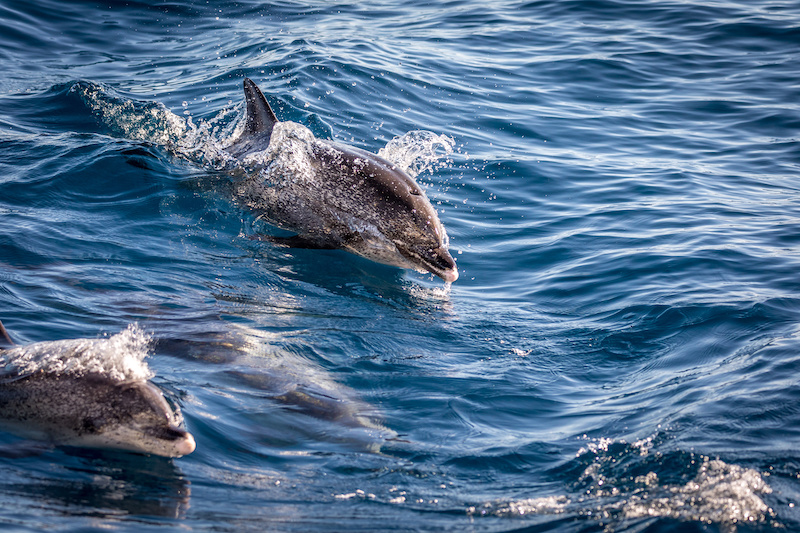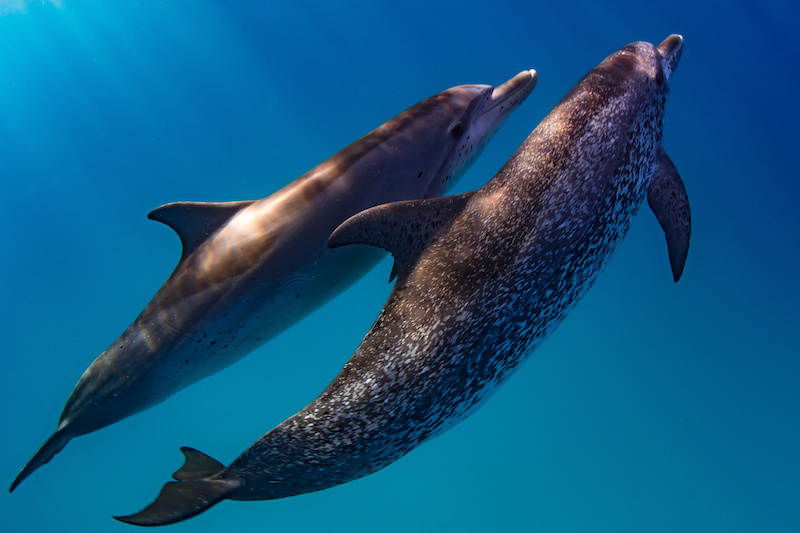
Dive into the fascinating world of the Spotted Atlantic Dolphin, a gem of the Caribbean waters. This article takes you on a journey to discover this amazing marine mammal, unveiling its secrets from its unique taxonomy to its specific dietary habits. Get ready to be amazed by the wonders of nature and enhance your knowledge about the Spotted Dolphin.
Characteristics of the Spotted Atlantic Dolphin
The Spotted Atlantic Dolphin, scientifically known as Stenella frontalis, is a fascinating marine mammal that captivates with its unique features. Belonging to the Delphinidae family, it stands out with its modest size, typically measuring between 2 and 2.5 meters and weighing around 140 kilograms. Its remarkable longevity, reaching up to 50 years, attests to its robustness and successful adaptation to the marine environment. Visually, this dolphin is easily recognizable by its skin adorned with gray spots, which vary in intensity and distribution based on the individual’s age and gender. These spots, lighter on the back and darker on the belly, give it a distinctive and elegant appearance.
Morphologically, the Spotted Atlantic Dolphin has a sleek and powerful body, adapted for fast and agile swimming. Its dorsal fin is large and falcate, a crucial feature for identification at sea. The dolphin’s head features a well-defined rostrum and a prominent melon, aiding in echolocation, a crucial sense for navigation and hunting in ocean depths. These characteristics, combined with its gregarious behavior and playful nature, make the Spotted Atlantic Dolphin an iconic species in the tropical and subtropical waters of the Atlantic, where it gracefully maneuvers with agility.

Habitat of the Spotted Dolphin
The Atlantic Spotted Dolphin (Stenella frontalis) primarily inhabits warm and temperate waters of the Atlantic Ocean, where it finds a favorable environment for its development. This species prefers coastal areas and shallow waters, but it is also capable of adapting to deeper and more open-sea environments.
It is often found in the Gulf Stream, a warm and powerful ocean current that provides an abundance of food and ideal conditions for its survival. The Bahamas are another favored location for these dolphins, where they take advantage of clear waters and shallow sandy bottoms. Their presence in these regions is an indicator of the health of marine ecosystems, as they play a crucial role in maintaining the balance of the marine food chain. Therefore, the conservation of their habitat is essential for preserving biodiversity and the overall health of the oceans.
Reproduction in the Atlantic Spotted Dolphin
The reproduction of the Atlantic Spotted Dolphin, Stenella frontalis, is a complex and fascinating process, crucial for the species’ sustainability. Sexual maturity is typically reached around the age of 15, marking the beginning of their reproductive capability. Gestation lasts approximately 11 to 12 months, during which the female carries her single calf.
After birth, the young dolphin remains closely bonded with its mother, who nurtures and protects it for several years, a crucial phase for its development and learning survival skills. Births occur every 3 to 4 years, allowing the mother to dedicate sufficient time and energy to raising each calf. This reproductive strategy, focused on intensive and prolonged care for the young, contributes to the strong social cohesion within dolphin groups and plays a vital role in maintaining the population of this species in its natural habitat.

Diet of the Atlantic Spotted Dolphin
The diet of the Atlantic Spotted Dolphin, Stenella frontalis, is varied and adapted to its marine environment. This species is primarily piscivorous, feeding on a wide variety of fish found in the tropical and subtropical waters of the Atlantic. In addition to fish, their diet includes crustaceans and cephalopods such as squid, which they skillfully hunt.
Their diet slightly varies depending on whether they are near the coast or in open waters. In coastal areas, they consume more reef fish and small marine invertebrates, while in open waters, they target pelagic prey, thus adapting their diet to the available resources. This dietary flexibility is essential for their survival as it allows them to adapt to seasonal variations in food availability in their natural habitat.
Discover all the cetacean species that can be found near the coasts of Martinique: